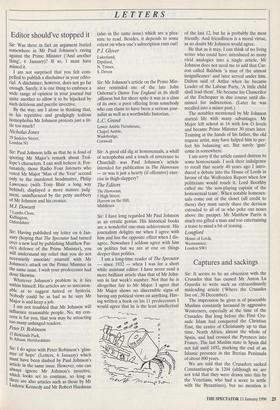Captures and sackings
Sir: It seems to be an obsession with the Crusades that has caused Mr Anton La Guardia to write such an extraordinarily misleading article ('Where the Crusades live on', 30 December).
The impression he gives is of peaceable Muslims constantly harassed by aggressive Westerners, especially at the time of the Crusades. But long before the First Cru- sade Islam had conquered the Christian East, the centre of Christianity up to that time, North Africa, almost the whole of Spain, and had crossed the Pyrenees into France. The last Muslim state in Spain did not fall until 1492, marking the end of an Islamic presence in the Iberian Peninsula of about 800 years.
We are told that the Crusaders sacked Constantinople in 1204 (although we are not told that they were drawn into this by the Venetians, who had a score to settle with the Byzantines), but no mention is made of the capture and sack (especially of its Christian heritage) of this city by the Ottoman Turks in 1453. Nor is there any mention of this people's drive into Europe as standard-bearers of a militant Islam, which had begun 100 years earlier, resulting in a centuries-long occupation of the Balka- ns, most of Hungary, and two determined attempts to capture the Habsburg capital of Vienna, the last as late as 1683, 400 years after the Crusader States had disappeared.
The picture then, from about 600 AD to 1800, is not of Muslims harassed by Chris- tians, but of Christendom desperately warding off the assaults of an aggressive Islam. The Crusades were an attempted counter-attack, which in the end failed to regain any territory that had formerly been Christian.
Westerners did not begin to dominate the Middle East until the 19th century, when religion had ceased to be their prima- ry motivation.
David S.M. Williams
555 Green Lanes, London N13







































 Previous page
Previous page